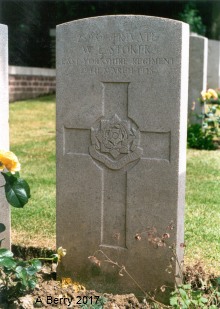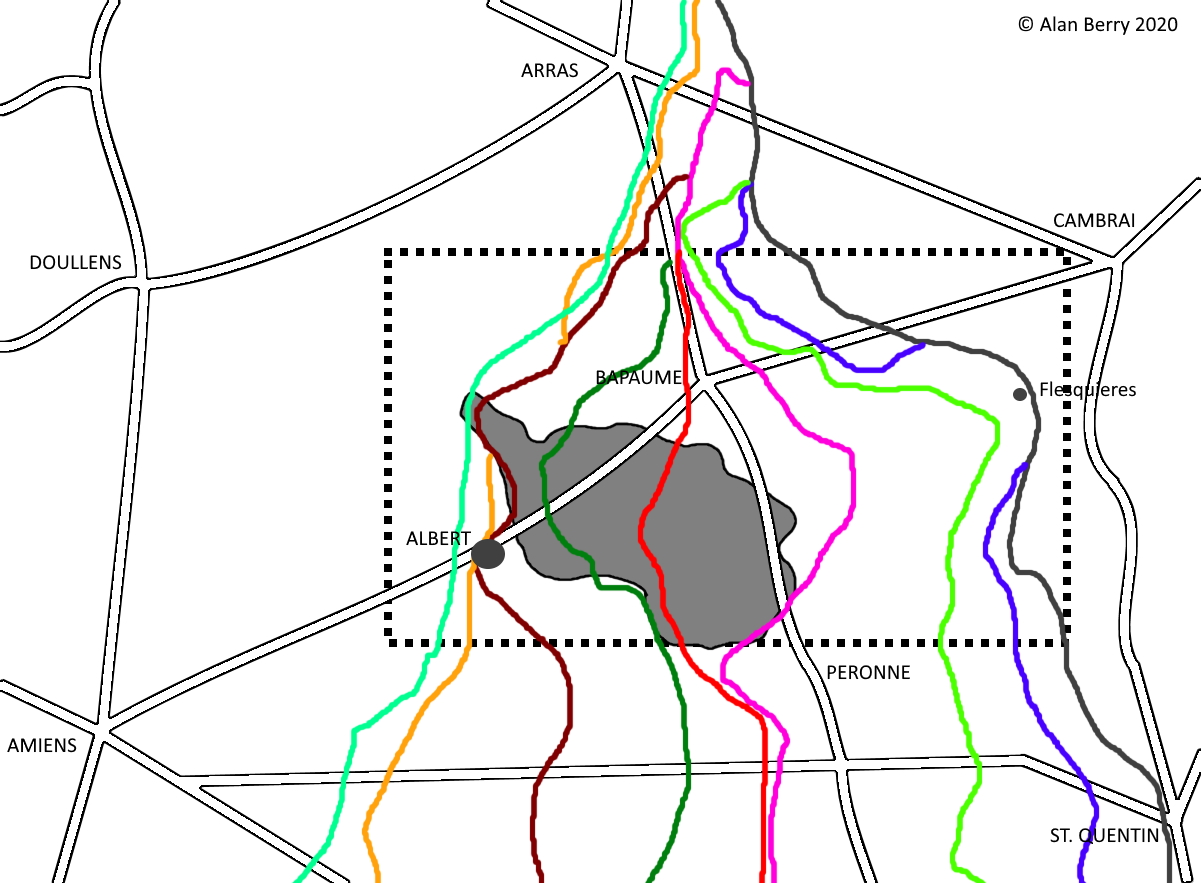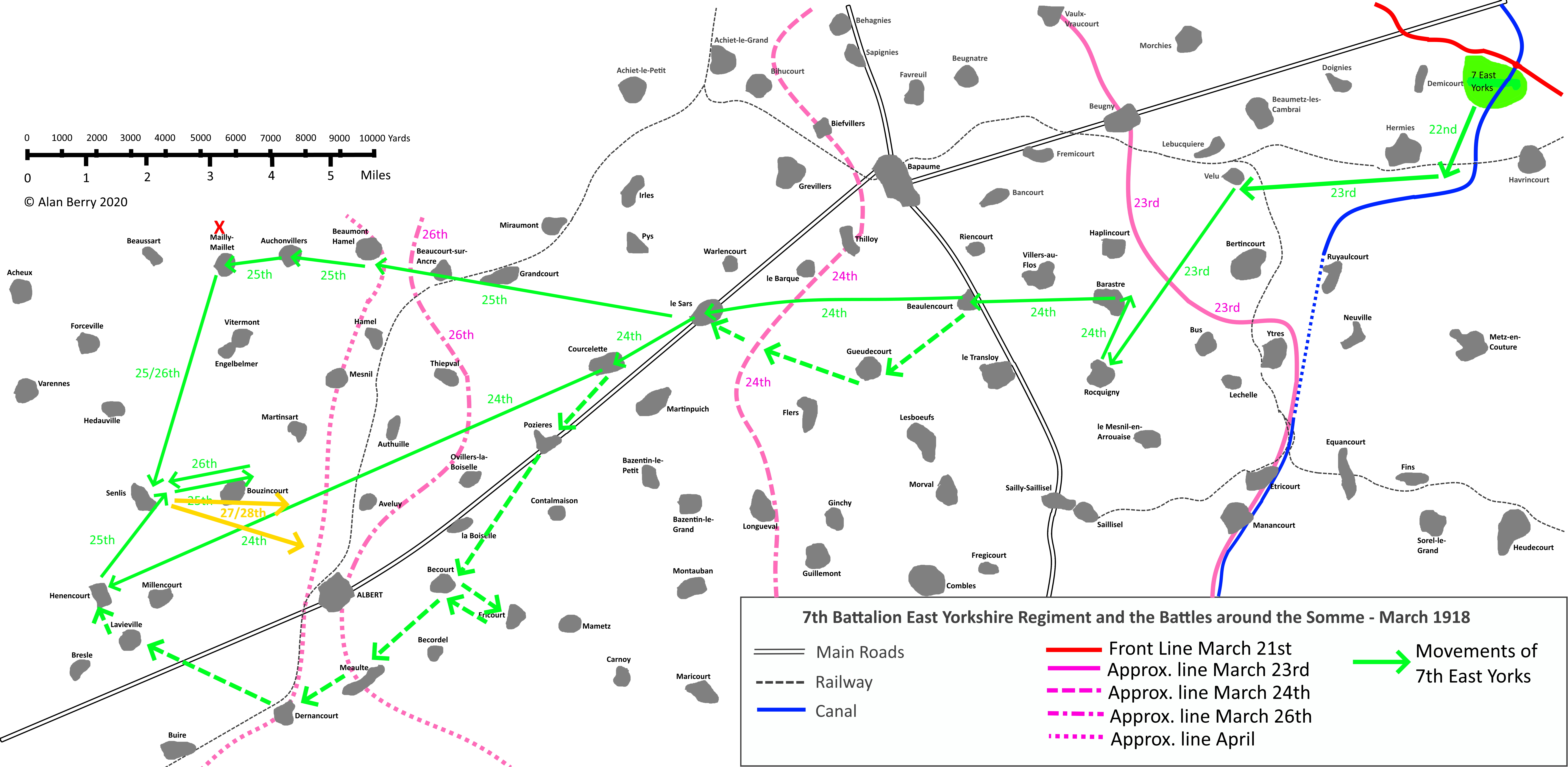THE VILLAGERS OF COLLINGHAM AND LINTON WHO SERVED IN WORLD WAR ONE
COLLINGHAMANDDISTRICTWARARCHIVE.INFO
 CONTACT
CONTACT



Rank Private
Service Number 25939
Service Army
Battalion 7th Battalion
Regiment East Yorkshire Regiment
Killed in Action: 29th March 1918
Buried Hermies Hill British Cemetery, France
Trade or Occupation pre-war: Market gardener
Marital status: Married
* Taken from attestation papers or 1911 census
** Marital status on enlistment or at start of war
- Born in Collingham, Linton or Micklethwaite
- Lived in Collingham, Linton or Micklethwaite immediately prewar or during the war
- Named on war village memorials or Roll of Honour
Biography
Family background
William Lee Stoker was born in Collingham on the 3rd April 1891, the son of Alfred and Hannah Stoker. William was baptised in St.Oswald's church on the 26th April 1891 and was later confirmed in Wetherby on the 18th February 1907 along with Alan Wilson and Raymond Johnson.
In 1910, on the 13th June, William married Annie Elizabeth Thirlwall in St. Oswald's church, and they had two children, Dorothy Gertrude Stoker and Kathleen Margery Stoker. On census day 1911, William was living at 8 Rider Place, Collingham with his wife and daughter, Dorothy.
Service record
William Lee Stoker enlisted in Wetherby on the 4th December 1915 and was immediately placed into the reserve. He was finally mobilised on the 21st June 1916. His initial posting was on the 27th June, to 9th Battalion East Yorkshire Regiment, at that time based in Harrogate. This battalion moved, in September to Rugeley Camp, on Cannock Chase. On the 29th August William was transferred to the 3rd Battalion East Yorkshire Regiment, then at Withernsea. William first went overseas, to France, on the 4th December 1916, and transferred to the 1st Battalion East Yorkshires, part of 64th Brigade in 21st Division. William's surviving service record shows a final transfer was made from the 1st to the 7th Battalion on the 14th December 1916. 7th Battalion East Yorkshire Regiment were part of 50 Brigade in 17 Division.
William was taken ill on the 30th December 1916 and was admitted for treatment, at first for a pyrexia of unknown origin, but then, on the 31st December 1916, to No. 6 General Hospital in Rouen suffering from bronchitis. William continued his treatment later in Etaples before returning to his battalion on the 10th March 1917.
If we are to believe a later report in the Wetherby News, William Stoker had a few days leave in early March 1918, returning to his unit around the 22nd February 1918. Just after that, in early March, the 7th East Yorkshire Regiment were in the front and support lines near Hermies (Maps 1 & 2).

Map 1: The northern part of the area covered by the German Operation Michael (click for full size). Successive front lines over the period of the operations are shown. The rough area covered by Map 2 is shown in a dashed box. The dark grey area shows the position of the Somme Battlefields of 1916.
On the 21st March 1918, Germany unleashed Operation Michael. On the 22nd, the first breakthrough occurred and by 26th March the lines of the British 5th Army were close to total disintegration. Between the 26th and 27th many successive positions were taken up but were rapidly given up again as the German onslaught continued. The 7th East Yorkshire Regiment, including William Stoker, were at the heart of this, given they were manning the front and support lines close to Hermies. Their movements over the next few days were chaotic, and this is reflected in the War Diary for the period. From the diary it is possible to piece together something of their movements, and these are illustrated in Map 2.

Map 2: The movements of the 7th Battalion East Yorkshire Regiment during late March 1918 during the German Operation Michael (click for full size). The war diary is somewhat confused and this is reflected in the movements shown. These movements may not track the exact routes that the men took, and given that the Battalion became split during the retreat there were many stragglers and the exact routes taken will probably never be known.
On the 21st March the section of line held by 50th Infantry Brigade (composed of the 10th Battalion West Yorkshire Regiment, the 6th Battalion Dorset Regiment and the 7th Battalion East Yorkshire Regiment) was subjected to heavy bombardment with high explosive and gas shells forcing the East Yorkshires to spend six hours wearing their box respirators. This was followed by the main attack. The Brigade held the enemy advance in its sector but penetrated a neighbouring section to attack the West Yorkshire's flank. No further breakthroughs were achieved but at night the evacuation of the front line was ordered and the brigade fell back, the East Yorkshires to the outer defences of Hermies and Havringcourt in an old British front line near the slag heaps. Next day (22nd) the East Yorkshires were a main target as the enemy attempted to break through. The Germans were initially beaten back, but at 2pm, another retirement was ordered, to Maxwell Avenue between Hermies and the Canal du Nord. This position was held during the night of the 22nd - 23rd March (Map 2).
From early on the 23rd, the enemy attacked again and again in the Divisional Front, but were driven off. However the state of the front was uncertain and breakthrough occurred such that, just after noon, the 7th East Yorks fell back again, retiring through the 2nd Division to the line around Velu Wood. From there they moved back further to Rocquiny, where they bivouaced for the night.
The 24th dawned clear and bright. 50th Brigade was ordered to counter attack and recapture Bus, but these orders were cancelled and instead the 50th Brigade were called upon to take up an outpost line around Barastre to cover the withdrawal of 63rd and 2nd Divisions. The Battalion then fell back through Beaulencourt to Le Sars, although the Battalion Headquarter's war diary suggests this withdrawal may have been through Gueudecourt. At this point the confusion of the battlefront becomes clear in the war diary, with the following entry, followed by two separate entries for the 25th.
The confusion was almost certainly caused by orders being issued and countermanded while they were still being carried out and by the speed of the German breakthrough. Thus one part of the Division was withdrawing through Courcelette to Henencourt, while another part followed a revised order to move to Gueudecourt.
For that part of the Battalion headed for Gueudecourt, the Brigade War Diary records:
The Brigade War diary also gives an account of the movements of the other part of the Brigade and 7th East Yorks Battalion:
O.C. 50th brigade stragglers carried out these orders by leading his force from Pozieres via Becourt to Fricourt. Here he was unable to get in touch with any one except two batteries of the RGA who were reconnoitring routes for withdrawal. He therefore withdrew to Becourt and applied to the division for instructions. As a result of these the force (consisting now of considerable numbers of each battalion, A company 17th Machine Gun Battalion, 50th Trench Mortar Battery, 78th and 93rd Field Companies, and part of the York and Lancaster regiment) was put under the command of Major Cubbon RE.
26th March. This force had taken up an outpost line east of Fricourt with the 52nd and 51st brigades on the left but at 2am the division was ordered to continue the withdrawal while the 37th infantry brigade which had just come up occupied the line. The West Yorkshire regiment furnished the rearguard to this force as it marched through Meaulte, Dernancourt and Lavieville to Henencourt arriving there are 9am.
3.30pm: the division issued orders for a move to Senlis - the 50th Brigade acting as rearguard. Four tanks were allotted to the brigade and the move began at 6.00pm.
7pm The 51st and 52nd Brigades moved into Senlis but the 50th brigade was diverted to the high ground to the south as it seemed probable that it would have to be used for a counterattack in the direction of Albert. Major Cubbon therefore went to learn the situation from the GOC 36 Brigade at Bouzincourt.
10.30pm. Division wired as follows: Albert appears to be full of the enemy, who crossed the Ancre. The 12th Division appeared to hold the line of the railway. South of this the situation is obscure. A brigade of the 63rd division is reported to be on the move from Martinsart to Albert via Bouzincourt. It is advisable for the 52nd brigade to arrange with the 51st brigade to form a defensive flank towards Albert till the situation in the north becomes more clear.
But what of the part of the East Yorkshire who had made towards Gueudecourt? We had left them on the 24th passing through Eaucourt L'Abbaye to Le Sars. Their movements are summarised in another part of the Brigade War Diary:
26th March. A sideslip was ordered and position held east of Beaumont Hamel (HQ at Auchonvillers). The enemy attacked several times without success, but finally occupied Beaumont Hamel and began to enter Colincamps. The New Zealand Division came up, drove the enemy through Beaumont Hamel and reinforced the line of the 50th Infantry Brigade and 2nd Division. At night the Brigade withdrew and rejoined the 17th division at Senlis in the morning.
The Battalion War Diary adds a little more detail.
Thus, by the morning of the 27th March the Battalion appears to have reformed around Senlis. However things were clearly still confused. The Battalion War Diary is silent on events for the next few days, but the Brigade Diary tells us a little of what was happening. After a general stabilisation of the front in the sector, the East Yorkshires and the rest of 50th Brigade first reconoitered a region south east of Bouzincourt and then took over a section of the front. On the brigade front the enemy had dug in and used machine guns with considerable effect from buildings on the outskirts of Albert. Our font line at that point consisted of rifle pits and old trenches which gave little cover. At 12.45 the advanced HQ at Senlis Mill was shelled and had to withdraw to the south edge of Senlis. On the 28th the situation on the left of the Brigade front was reported to be unsatisfactory and 50th Brigade were ordered to ensure the safety of the high ground as far as Bouzincourt. 20 light tanks were brought to Henencourt for counter attacks. By 4pm the situation on the left was reported as satisfactory and at 6.30 the line moved forward. On the 29th March, at 7.20am, the enemy rushed the posts dug the previous night and held them. Casualties were estimated as 15. Later parties of the enemy tried to rush the British Lewis Rifle post but were driven off and they dug in.
William Lee Stoker was killed in action on the 29th March 1918. Some confusion over the date of William's death arises because a number of documents from the Commonwealth War Grave Commission give William's date of death as 29th September 1918. However, given the dates of various newspaper articles (see below), this latter date must be wrong. According to the Commonwealth War Graves Commission, William's body was initially buried at a map reference of Q1.A.3.2 along with four unknown soldiers of the East Yorkshire Regiment. However this grave position raises a few more questions. It is marked by a red cross on Map 2, near Mailly Maillet. However, by the 29th the East Yorkshires were further south near Bouzincourt, as described. We will probably never know whether William was wounded on the 25th while they were close to Mailly Maillet and died on the 29th, whether a mistake was made with the date, or whether an aid post was stationed there where he was evacuated from the front on the 29th and where he died. After the war, a number of small burial sites were moved and the bodies exhumed and re-buried. William Lee Stoker is now buried in Hermies Hill British Cemetery, France.
At home, William's death was recorded by The Wetherby News on 19th April 1918:
Official intimation was received on Tues of the death in action, in France, on March 29th, of Private William Lee Stoker, of School Lane, Collingham. Private Stoker was home on leave a recently as February, returning to the front on the 22nd. He went out to France in December 1916, and would have been 28 years of age on April 3rd, five days after he met his death. Deceased leaves a widow and two children, and a widowed mother, to mourn his loss. A brother-in-law of the deceased, Gunner Geo. Elliot Dawson, was seriously wounded on the 3rd November 1917, and died two days after. Pte. Stoker was of a bright and cheerful disposition, and was well liked by all who knew him. He was formerly employed by Mr Arthur Smith, draper and outfitter, of Collingham and Leeds, as a warehouseman.
There was also a report in the Collingham Parish Magazine:
On March 29th, William Lee Stoker, of the 7th Battalion East Yorkshire Regiment, was killed in Action. He was born in Collingham, and his mother’s family have long lived in the parish. Our sympathy will be with his widow and children, and with his mother, who has now lost a son and son-in-law in the war.
William's brother in law was George Elliott Dawson who also gave his life in the Great War.
Biography last updated 24 March 2020 17:55:12.
Sources
1911 Census. The National Archives. Class RG14 Piece 25962
The Wetherby News 19/4/1918
The Collingham Parish Magazine May 1918
First World War Medal Index Cards. The National Archives (WO372).
First World War Medal Index Rolls. The National Archives (WO329).
First World War British Army Service Records. The National Archives (WO363).
War Diary of 7th Battalion East Yorkshire Regiment (WO95/2003) The National Archives.
War Diary of HQ 50th Infantry Brigade (WO95/1999) The National Archives.
Commonwealth War Graves Commission Cemetery and Burial Reports
Pension Record Cards and Ledgers. Case number 4/W/642 & 4/APW/642
If you have any photographs or further details about this person we would be pleased to hear from you. Please contact us via: alan.berry@collinghamanddistrictwararchive.info